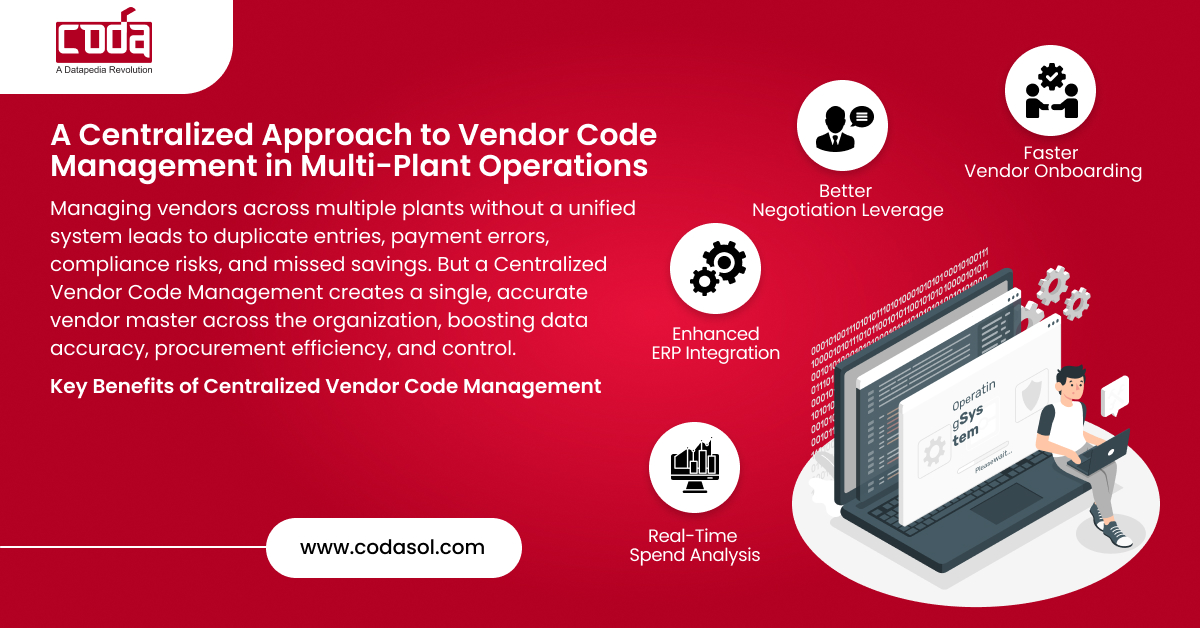TL;DR: Why Centralized Vendor Code Management Matters
If you’re juggling procurement across multiple plants, scattered vendor records can lead to duplicate payments, delayed onboarding, and missed savings. Centralized Vendor Code Management creates a unified vendor master across your organization, improving data accuracy, compliance, and cost efficiency. Tools like PROSOL simplify this transformation with automation, governance, and ERP integration.
Why Vendor Code Chaos Hurts Multi-Plant Operations
Imagine this: you’re managing procurement for a company with plants in three countries. Each plant uses its own vendor codes, naming conventions, and onboarding practices. The same vendor might appear under three different names in your ERP. Now multiply that confusion by hundreds of vendors.
The result? Duplicate payments, fragmented negotiations, compliance risks, and poor vendor performance visibility. In a world where procurement is expected to drive strategic value, not just savings, this chaos isn’t just inconvenient. It’s costly.
This is where Centralized Vendor Code Management becomes a game-changer. It offers a single source of truth for vendor data across the enterprise.
What Is Centralized Vendor Code Management?
Centralized Vendor Code Management is a master data strategy where a single, standardized vendor master is used across all plants, regions, or business units. Instead of siloed databases and redundant entries, every department pulls from a unified, validated, and consistently updated source.
This strategy reduces duplication, simplifies compliance, strengthens vendor relationships, and streamlines enterprise-wide procurement.
Why It Matters Now, More Than Ever
Global operations demand agility. Companies in sectors like Oil & Gas, Utilities, and Manufacturing often operate across borders, languages, and systems. With rising geopolitical uncertainty, fluctuating raw material prices, and increasing regulatory scrutiny, having visibility and control over your vendor ecosystem is no longer optional, it’s essential.
Key Benefits of Centralized Vendor Code Management
| Benefit | Description |
|---|---|
| Elimination of Duplicates | One vendor, one code. Prevents double payments and over-ordering. |
| Faster Vendor Onboarding | Reusable codes streamline the vetting and onboarding process. |
| Better Negotiation Leverage | Global visibility into spend volumes enables stronger contract terms. |
| Improved Compliance | Align with internal and regulatory standards across geographies. |
| Enhanced ERP Integration | Unified vendor master simplifies system-wide integration. |
| Real-time Spend Analysis | Consolidated vendor data supports actionable, strategic insights. |

Ready to eliminate duplicate vendor records and cut procurement costs?
A Step-by-Step Framework
- Audit Existing Vendor Data
Identify all existing vendor records across plants and systems. Look for duplicates, outdated records, and inconsistencies. - Define Standardized Taxonomy
Agree on naming conventions, categorization, and mandatory fields (e.g., PAN, VAT ID, bank details). - Create a Central Governance Team
Assign roles for validation, updates, and periodic reviews. - Implement a Unified MDM Platform
Use tools like PROSOL, a cloud-based master data governance tool. PROSOL is a web-based solution that manages and standardizes MRO master catalog data. It enforces best practices through structured templates and business rules aligned with global standards like MESC, UNSPSC, and ISO 8000. - Integrate Across ERP Systems
PROSOL integrates seamlessly with SAP and Oracle systems via IDoc, BAPI, RFC, NetWeaver (SAP) or Fusion Middleware (Oracle). It supports unidirectional, bidirectional, and bulk upload workflows, offering flexibility in integration models. - Train Stakeholders Across Plants
Conduct workshops to align plant-level teams with the new centralized process. - Monitor & Improve Continuously
Track metrics like vendor duplication rate, onboarding time, and compliance adherence. Set clear benchmarks to measure success.
What Makes PROSOL Different?
- Catalog Management & Data Control: Tools for new item creation and end-to-end lifecycle governance
- Data Quality: Up to 60% reduction in duplicate records, with compliance to ISO and industry standards
- Enhanced Accessibility: Advanced search with filters for classification, supplier, UNSPSC, and reference fields
- Description Automation: AI-driven short and long description generation
- Rich Attachments: Support for images, documents, and reference catalog links
Use Case for Centralized Vendor Code Management:
A leading steel manufacturer in Saudi Arabia operated five plants, each maintaining separate vendor masters. Procurement faced constant issues:
- Same vendor registered under five different codes
- Missed bulk discount opportunities
- Delayed payments due to inconsistent records
After implementing centralized vendor code management with PROSOL:
- Vendor duplication dropped by 67%
- Average onboarding time reduced by 40%
- Procurement savings increased by 12% within the first year
“We gained full control over our vendor data. It helped us negotiate better and comply faster.”
– Procurement Head, Steel Manufacturer
Curious how PROSOL fits into your digital transformation journey?

Common Challenges & How to Overcome Them
- Resistance to Change: Involve stakeholders early. Use pilot projects to demonstrate value.
- Data Silos: Use automated data migration and cleansing tools to unify records.
- Lack of Expertise: Partner with experienced data governance teams or platforms like CODASOL.
When to Consider Centralization
You should explore centralized vendor code management if:
- You have 2 or more operational plants or business units
- You suspect duplicate vendors in your ERP
- Your vendor onboarding takes too long
- Compliance audits flag inconsistencies
Frequently Asked Questions
1. How do I know if I have duplicate vendor codes?
Run data profiling tools across ERP systems or consult an MDM platform to identify name, address, or tax ID matches.
2. Can centralized vendor data integrate with multiple ERPs?
Yes. Tools like PROSOL are designed to integrate seamlessly with major ERPs, providing a consistent view.
3. What’s the ROI on implementing centralized vendor code management?
ROI varies, but companies typically recover costs within 6–12 months through savings, reduced errors, and faster operations.
4. Will this work across global operations?
Absolutely. Centralization supports multi-language, multi-currency, and multi-regional compliance needs.
5. What should I look for in a vendor master data platform?
Ensure it offers real-time updates, deduplication algorithms, audit trails, and seamless ERP integration.
By shifting from fragmented vendor data to a centralized model, multi-plant organizations can unlock hidden value, reduce risks, and power smarter procurement decisions.
Don’t let vendor data be the weak link in your operations. Centralize today.

Want to see how centralized vendor code management works in real-time?

